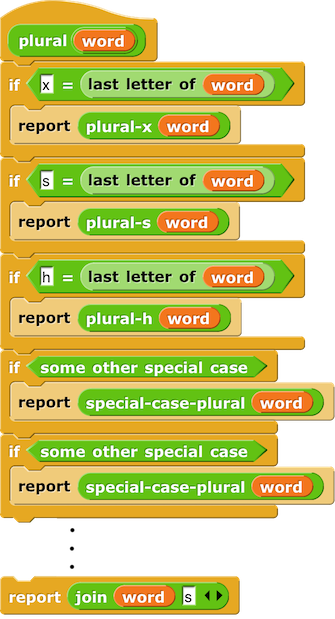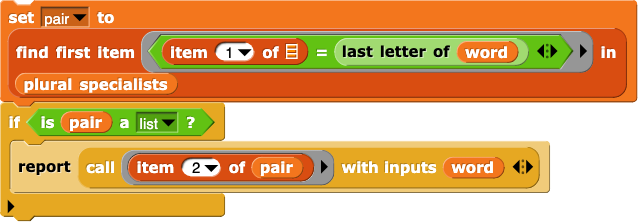-
Abstraction: Make a
 block that "specializes" on just one category, words that end with the letter "h".
block that "specializes" on just one category, words that end with the letter "h".
- Start with a
listof the words you want it to work for. - This specialist block should work correctly for words that fit its specialty

 ,
,  . It can be completely wrong about words that don't fit its specialty
. It can be completely wrong about words that don't fit its specialty result.png) because the
because the pluralblock should never give words toplural-hunless those words end with "h". -
Test
 with a variety of words to make sure it works the way you want. Then use
with a variety of words to make sure it works the way you want. Then use mapto test it on the entire list you made earlier.Click for a hint about creating a test list of words that begin with "h".Because you know what-equals-h)-from-test-list.png) does, you can use its output as input to a test of
does, you can use its output as input to a test of pluralorplural-h:
-over-(keep-items-such-that-(last-letter-of-(input)-equals-h)-from-test-list).png)
- Start with a
- When you trust your new specialist block, edit
pluralto use the specialist. Test (you can usemap) to make surepluralstill works for all the words it used to work for, as well as the new ones. - Create
plural-yto handle words like and
and

Abstraction: Language often has special cases. In English, the plurals of some nouns add "s"; some add "es"; nouns like "calf" and "fly" become "calves" and "flies", changing their final letters before adding "es". And more. For a programming task this complex, it's (generally) best to break it into parts, handle each part separately with its own procedure (its own block), and then have the "top-level" block—in this case, plural, itself—use those specialists. That is, instead of coding every little detail directly in plural, it is cleaner and clearer to make plural look something like this.

Showing the structure of the method—just the overall strategy—in the "top-level" block and leaving the details to separate blocks is one part of an important computer science idea called abstraction. Abstraction keeps your code clear, readable, and more easily debugged. It will also help your code be more flexible.
result.png)
Make sure
plural gives plural-y only words it knows how to handle correctly.


.png)
.png)
 . That works too! But why?
. That works too! But why?


